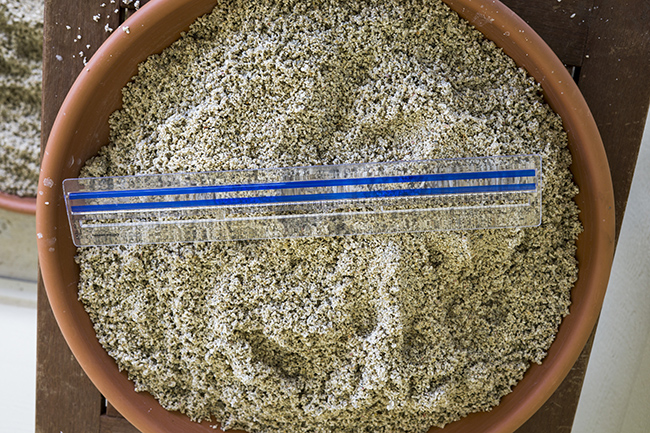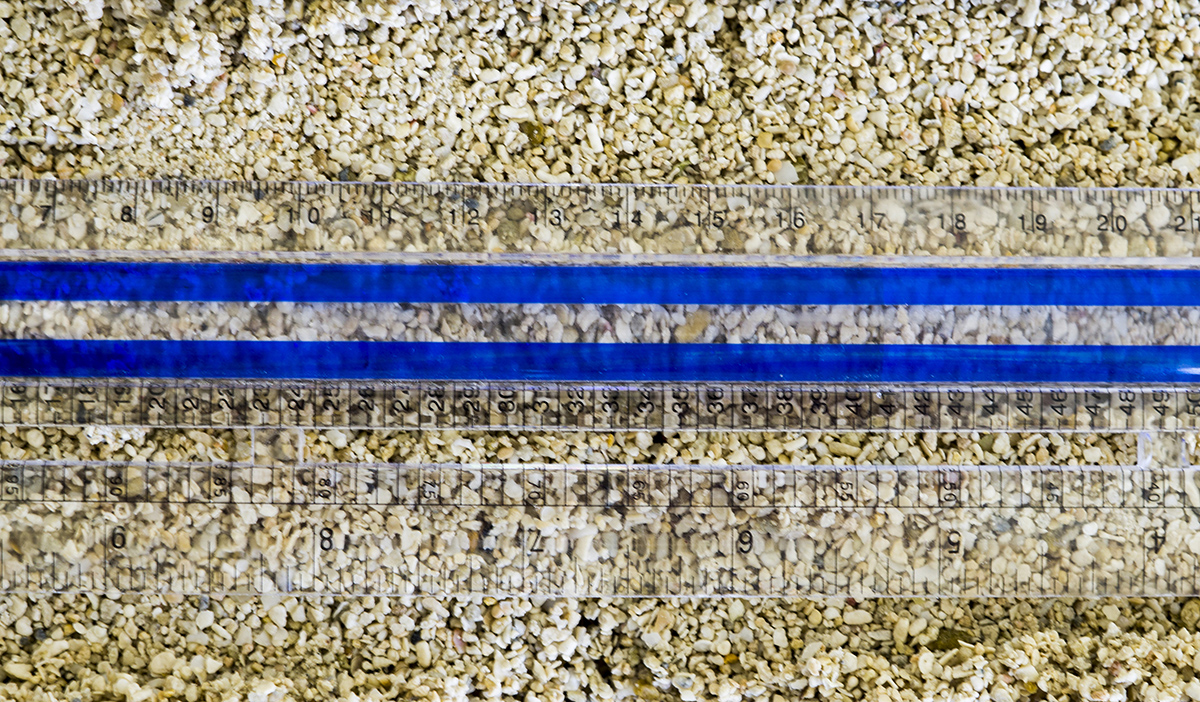CaribSea aragonite special grade reef sand — aquarium substrate — a review
© 2018 Peter Free
17 September 2018


Aquarium sand that works well — with occasional shortcomings
CaribSea's cream-colored aragonite special grade reef sand solves the problem of substrate being blown around by aquarium pumps and water changes. Its particle sizes are advertised as 1.0 to 2.0 millimeters.
I bought the "special grade reef sand" for fresh water use, after CaribSea's black Tahitian moon sand proved to be too easily disturbed.
Every time I did anything in the tank, the black sand would coat plants and rocks. Appreciable amounts of it also siphoned out, no matter how careful I was. Pretty stuff, but too much of a cumulative annoyance, given how difficult it was to maneuver a small siphon around the aquarium landscape.
In contrast, the special grade reef sand mostly stays in place. One does have to be a bit careful when refilling, after water changes. Turbulence carelessly generated stirs the sand up.
Another benefit to the larger particle sizes (in the special grade aragonite), is this sand's ability to avoiding being sucked completely out of the tank, while siphoning.
That's an obvious plus, when it comes to cleaning. You can swirl the sand around in the siphon tube, without worrying about it leaving the tank.
On the other hand, the sand's density becomes a negative, when you would like to siphon the substrate completely out of the tank. Even a large Fluval GravelVac could not suck appreciably much special reef sand into a bucket.
In sum, although the special grade sand solved one time-consuming aquarium glitch, it created two others that eventually had me replace it with gravel.
Characteristic 1 — turbidity
If disturbed, this sand produces turbidity. Always.
The aragonite sand particles grind against each other, rubbing off chalk-like dust. The more you move the sand around in the initial rinse bucket (or in the aquarium), the more of this fine sediment you will produce.
Thus, the aragonite is impossible to rinse clean, before the first use. You will have to dump it into your tank, after doing your best to reduce the voluminous amounts of cloudy rinse water that it gives off.
After putting "special grade" into your aquarium, you will have to wait a couple of days for filters and settling to remove unavoidable cloudiness.
This inability to get the substrate clean is not CaribSea's doing. It's just the material's nature.
Turbidity may show up again, when it comes time to remove the sand completely. Turbidity complicates substrate removal (and replacement), when you are working with a critter-filled tank.
Lifting the sand out stirs everything up so much that the water becomes opaque. You cannot see the tank's inhabitants. And they cannot see your hand in the water. This freaks them out.
If you have shrimp in this mess, you will not immediately know whether you inadvertently scooped them up and pitched them with the muddy water.
I noticed that my Amano shrimp were determined to stay with the sand. They braved my scoops, even when only a very small pile of sand remained in the aquarium.
There is a paradoxical benefit to the special grade sand. Much of its chalky sediment eventually settles to the bottom of the (now substrate-free) aquarium.
If you give the settling process about an hour, you will see the chalk-like sediment lying in white patches (under the water) on the glass floor.
You can suck these patches out with a small siphon.
Python's small Pro-Clean siphon works well for this. After three go rounds, with settling time allowed between each, I had most of the white sediment out of my tank.
Characteristic 2 — the sand's off-white color looks good — only when it is absolutely clean
My three mature tanks are subject to relentless brown diatom growth. This trait is apparently due to the local tap water's high silicate load and high pH. Changing light duration and intensity makes no difference. Neither does using a silicate remover. Water parameters are fine.
Diatoms eventually begin coating the aragonite sand, making it a nasty brown color.
Green (on-sand) algae — which escapes the tank's Nerite tiger snails and Amano shrimp — does its anti-aesthetic part, as well. The algae creates green layers in the sand at the front and sides of the tank. These are, however, less obnoxious to my eye than the diatoms.
During siphoning, you can bury the diatom and algae layers where they cannot be seen. But the process stirs up chalky clouds that take a day or two for cannister filtering to remove.
I also thought that some of the live buried material would wind up in anaerobic areas of the substrate and decompose. Perhaps posing a health hazard to the aquarium's population.
As a result, I eventually replaced the special grade reef sand with red-brown gravel. The gravel does not show brown diatoms as obviously as the sand does. And it is very much easier to clean.
Caveat — a quibble regarding product packaging
The following regards knowing what you are getting. Which, with CaribSea is often more difficult to accomplish than it should be.
CaribSea, in my experience, seems to go out of its way to make it challenging to distinguish its products via their packaging and descriptions.
For example, in the case of aragonite special grade reef sand, only the word Aragonite is prominent on the 40 pound bag.
That is not helpful because CaribSea manufactures a herd of "aragonite" substrates.
To find "special grade reef sand", you have to go down to the bar code at the bottom front of the 40 pound bag. Very small black letters run in vertical lines along the bar code's right side.
These words are positioned, as if the bag is lying on its right side. That's a curious design choice because everything else on the package is written as if the bag is standing vertically.
The key letters say, Seaflor Special Grade Reef Sand.
Why CaribSea interjects Seaflor, when it does not use that word anywhere else in its advertising for "special grade" beats me.
To cap this example of marketing obtuseness off, CaribSea's website uses "Seaflor" and SeaFlor" — differently capitalized — to describe two other products in their marine substrate section.
Respectively, these are Flamingo Reef and Super Reef. But, as I have said, Seaflor is not used in the website's description of the "special grade" sand. Despite the fact that Seaflor appears on my sample of the product bag.
Does the word "dumb" apply?
Or is this a plot to confuse consumers?
Perhaps CaribSea hopes consumers will buy multiple different bags, so as to eventually receive the product they wanted.
Not being a conspiracist, I lean toward the "idiot" hypothesis.
It's probably a good thing these guys are dealing with sand, gravel and stones.
The moral? — CaribSea's aragonite special grade reef sand is a decent product
You will not go wrong, if:
(a) you know what to expect with regard this substrate's occasional water turbidity
and
(b) your conditions do not favor the growth of brown diatoms.
I will dry my "special grade" out, store and reuse it under more favorable circumstances.
 PeteFree.com
PeteFree.com